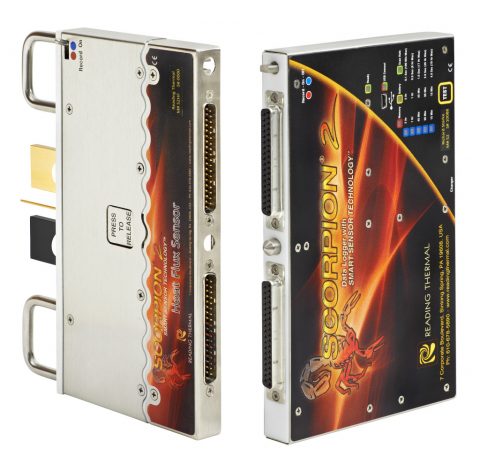Have you been troubleshooting your industrial bakery’s proofing, baking, cooling, or freezing processes? The Scorpion® 2 Profiling System from Reading Thermal will give you a precise picture of what is happening inside your commercial bakery ovens.
Reading Thermal, headquartered in Sinking Spring, PA, has been focused on studying the commercial baking process for more than 25 years. We have used that knowledge to manufacture and support the SCORPION® 2 Profiling System and Data Logger, a standard in the baking industry.
Connecting our various smart sensors and sensor arrays to the SCORPION® 2 Data Logger and putting them through the oven with your product allows the system to collect data on the four main baking parameters: temperature (including the temperature of both the air and the oven belt surface), heat flux (energy transfer), humidity, and airflow (velocity).
Measure Essential Baking Parameters
1) Temperature: Oven temperature impacts drying/dehydration, oven-spring, and color formation while baking. Temperatures that are too low or too high can lead to unwelcome changes in product texture and taste. The Scorpion® 2 Temperature Sensor Array measures temperatures at product level, in fixed positions across the conveyor, and delivers a precise picture of temperatures from side-to-side and end-to-end.
2) Humidity: Humidity often comes from the product itself and represents a delicate balance that can impact the quality of finished products. For example, humid air transfers heat to products more efficiently, cooking them more rapidly. Low humidity typically results in crustier bread, while high humidity can lighten the color of the crust and prevent it from burning. The new SCORPION® 2 Digital Humidity Sensor is designed to measure the moisture content of the thermal environment in heating and cooling processes. It applies to proofers, ovens, dryers, and cooling tunnels.
3) Heat flux: Many product characteristics are defined by the amount and type of heat applied during the baking process. The differences explain why one oven bakes differently than another. And analyzing and controlling these differences is essential in understanding how they will affect the finished characteristics of a product. The SCORPION® 2 Heat Flux Sensor measures radiant and heat fluxes at product level and displays the results in Btu/hr·ft2 or convective W/m2.
4) Air velocity: Airflow in a convection oven primarily comes from air distribution plenums. In a radiant oven, airflow comes from the moving conveyor, the exhaust system, and natural combustion air currents. It’s critical to measure oven air velocity with the SCORPION® 2 Air Velocity Sensor because airflow influences the final product’s texture, firmness, coloration, and baking time. The profiles will help you spot airflow differences between baking zones and undesirable air currents at the entrance or exit of the oven that can cause inconsistent baking.
The exceptional capabilities of the state-of-the-art SCORPION® 2 from Reading Bakery will help you with your industrial baking troubleshooting. Contact us online, or call (610) 678-5890 Ext. 2 to learn more.

